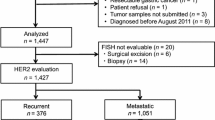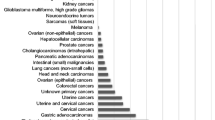Abstract
Background
Human epidermal growth factor receptor 2 (HER2) is an important proto-oncogene of prognostic use in gastric cancer (GC). Fluorescence in-situ hybridization (FISH) and immunohistochemistry (IHC) are the main clinical methods of detection of HER2, but consistency between the methods is poor and the cause of the discrepancy is unclear.
Aim
To investigate the involvement of HER2 mRNA status in the disparity between gene amplification and protein overexpression.
Methods
We investigated HER2 gene, mRNA, and protein profiles in gastric precancer and cancer tissues by use of the molecular approaches FISH, real-time polymerase chain reaction, and IHC. The relationships between HER2 and matrix metalloproteinase 9 (MMP9) and Smad7 expression were analyzed and the involvement of HER2 in the interaction between tumor cells and lymphocytes was investigated by coculturing GC cell lines with peripheral blood mononuclear cells (PBMCs).
Results
HER2 protein expression was significantly increased in cancer compared with precancer (P = 0.003), and the corresponding mRNA levels were significantly lower in precancer and cancer tissues than in normal tissues (κ = 0.290, P = 0.025). HER2 mRNA levels were significantly higher in tumor than in peritumor tissue (P = 0.028), and were positively correlated with MMP9 and Smad7 mRNA levels in tumor tissues. HER2 mRNA expression in GC cell lines was increased by coculture with PBMCs.
Conclusions
Different HER2 mRNA profiles, possibly in relation to contact between tumor cells and lymphocytes, might help to explain the discrepancy between gene amplification and protein overexpression results.



Similar content being viewed by others
References
Akiyama T, Sudo C, Ogawara H, Toyoshima K, Yamamoto T. The product of the human c-erbB-2 gene: a 185-kilodalton glycoprotein with tyrosine kinase activity. Science. 1986;232:1644–1646.
Borg A, Linell F, Idvall I, et al. HER2/neu amplification and comedo type breast carcinoma. Lancet. 1989;1:1268–1269.
Kesisis G, Kontovinis LF, Gennatas K, Kortsaris AH. Biological markers in breast cancer prognosis and treatment. J BUON. 2010;15:447–454.
Lorenzen S, Lordick F. How will human epidermal growth factor receptor 2-neu data impact clinical management of gastric cancer? Curr Opin Oncol. 2011;23:396–402.
Egeblad M, Werb Z. New functions for the matrix metalloproteinases in cancer progression. Nat Rev Cancer. 2002;2:161–174.
Albarello L, Pecciarini L, Doglioni C. HER2 testing in gastric cancer. Adv Anat Pathol. 2011;18:53–59.
Sornmayura P, Rerkamnuaychoke B, Jinawath A, Euanorasetr C. Human epidermal growth-factor receptor 2 overexpression in gastric carcinoma in Thai patients. J Med Assoc Thai. 2012;95:88–95.
Bang YJ, Van Cutsem E, Feyereislova A, et al. Trastuzumab in combination with chemotherapy versus chemotherapy alone for treatment of HER2-positive advanced gastric or gastro-oesophageal junction cancer (ToGA): a phase 3, open-label, randomised controlled trial. Lancet. 2010;376:687–697.
Arnold S, Mira E, Muneer S, et al. Forced expression of MMP9 rescues the loss of angiogenesis and abrogates metastasis of pancreatic tumors triggered by the absence of host sparc. Exp Biol Med (Maywood). 2008;233:860–873.
Kim YH, Lee HS, Lee HJ, et al. Prognostic significance of the expression of Smad4 and Smad7 in human gastric carcinomas. Ann Oncol. 2004;15:574–580.
Heikkinen PT, Nummela M, Jokilehto T, Grenman R, Kahari VM, Jaakkola PM. Hypoxic conversion of SMAD7 function from an inhibitor into a promoter of cell invasion. Cancer Res. 2010;70:5984–5993.
Kim S, Han J, Lee SK, et al. Smad7 acts as a negative regulator of the epidermal growth factor (EGF) signaling pathway in breast cancer cells. Cancer Lett. 2012;314:147–154.
Yannelli JR, Tucker JA, Hidalgo G, Perkins S, Kryscio R, Hirschowitz EA. Characteristics of PBMC obtained from leukapheresis products and tumor biopsies of patients with non-small cell lung cancer. Oncol Rep. 2009;22:1459–1471.
Nowak M, Klink M, Glowacka E, et al. Production of cytokines during interaction of peripheral blood mononuclear cells with autologous ovarian cancer cells or benign ovarian tumour cells. Scand J Immunol. 2010;71:91–98.
Poggi A, Zocchi MR. Mechanisms of tumor escape: role of tumor microenvironment in inducing apoptosis of cytolytic effector cells. Arch Immunol Ther Exp (Warsz). 2006;54:323–333.
Minot DM, Voss J, Rademacher S, et al. Image analysis of HER2 immunohistochemical staining. Reproducibility and concordance with fluorescence in situ hybridization of a laboratory-validated scoring technique. Am J Clin Pathol. 2012;137:270–276.
Ruschoff J, Dietel M, Baretton G, et al. HER2 diagnostics in gastric cancer-guideline validation and development of standardized immunohistochemical testing. Virchows Arch. 2010;457:299–307.
Ma GF, Miao Q, Zeng XQ, et al. Transforming growth factor-b1 and -b2 in gastric precancer and cancer and roles in tumor-cell interactions with peripheral blood mononuclear cells in vitro. PLoS One. 2013;8:e54249.
Cuadros M, Villegas R. Systematic review of HER2 breast cancer testing. Appl Immunohistochem Mol Morphol. 2009;17:1–7.
Hofmann M, Stoss O, Shi D, et al. Assessment of a HER2 scoring system for gastric cancer: results from a validation study. Histopathology. 2008;52:797–805.
Sauter G, Lee J, Bartlett JM, Slamon DJ, Press MF. Guidelines for human epidermal growth factor receptor 2 testing: biologic and methodologic considerations. J Clin Oncol. 2009;27:1323–1333.
Vanderhaegen J, Paridaens R, Neven P. Adjuvant trastuzumab in HER2-positive breast cancer. N Engl J Med. 2012;366:664–666.
Muller BM, Kronenwett R, Hennig G, et al. Quantitative determination of estrogen receptor, progesterone receptor, and HER2 mRNA in formalin-fixed paraffin-embedded tissue—a new option for predictive biomarker assessment in breast cancer. Diagn Mol Pathol. 2011;20:1–10.
Iverson AA, Gillett C, Cane P, et al. A single-tube quantitative assay for mRNA levels of hormonal and growth factor receptors in breast cancer specimens. J Mol Diagn. 2009;11:117–130.
Moerland E, van Hezik RL, van der Aa TC, van Beek MW, van den Brule AJ. Detection of HER2 amplification in breast carcinomas: comparison of multiplex ligation-dependent probe amplification (MLPA) and fluorescence in situ hybridization (FISH) combined with automated spot counting. Cell Oncol. 2006;28:151–159.
Tubbs RR, Pettay JD, Roche PC, Stoler MH, Jenkins RB, Grogan TM. Discrepancies in clinical laboratory testing of eligibility for trastuzumab therapy: apparent immunohistochemical false-positives do not get the message. J Clin Oncol. 2001;19:2714–2721.
Kuesters S, Maurer M, Burger AM, Metz T, Fiebig HH. Correlation of ErbB2 gene status, mRNA and protein expression in a panel of >100 human tumor xenografts of different origin. Onkologie. 2006;29:249–256.
Tanner M, Hollmen M, Junttila TT, et al. Amplification of HER-2 in gastric carcinoma: association with Topoisomerase IIalpha gene amplification, intestinal type, poor prognosis and sensitivity to trastuzumab. Ann Oncol. 2005;16:273–278.
Moelans CB, van Diest PJ, Milne AN, Offerhaus GJ. Her-2/neu testing and therapy in gastroesophageal adenocarcinoma. Patholog Res Int. 2011;2011:674182.
Pellikainen JM, Ropponen KM, Kataja VV, Kellokoski JK, Eskelinen MJ, Kosma VM. Expression of matrix metalloproteinase (MMP)-2 and MMP-9 in breast cancer with a special reference to activator protein-2, HER2, and prognosis. Clin Cancer Res. 2004;10:7621–7628.
O-Charoenrat P, Rhys-Evans P, Eccles S. A synthetic matrix metalloproteinase inhibitor prevents squamous carcinoma cell proliferation by interfering with epidermal growth factor receptor autocrine loops. Int J Cancer. 2002;100:527–533.
Asrani K, Keri RA, Galisteo R, et al. The HER2- and heregulin beta1 (Hrg)-inducible TNFR superfamily member Fn14 promotes HRG-driven breast cancer cell migration, invasion, and MMP9 expression. Mol Cancer Res. 2013;11:393–404.
Jang JY, Jeon YK, Kim CW. Degradation of HER2/neu by ANT2 shRNA suppresses migration and invasiveness of breast cancer cells. BMC Cancer. 2010;10:391.
Leng A, Liu T, He Y, Li Q, Zhang G. Smad4/Smad7 balance: a role of tumorigenesis in gastric cancer. Exp Mol Pathol. 2009;87:48–53.
Dowdy SC, Mariani A, Janknecht R. HER2/Neu- and TAK1-mediated up-regulation of the transforming growth factor beta inhibitor Smad7 via the ETS protein ER81. J Biol Chem. 2003;278:44377–44384.
Lu X, Liu J, Li H, et al. Conversion of intratumoral regulatory t cells by human gastric cancer cells is dependent on transforming growth factor-beta1. J Surg Oncol. 2011;104:571–577.
Acknowledgments
Research Fund of Zhongshan Hospital (2013ZSQN08).
Conflict of interest
None.
Author information
Authors and Affiliations
Corresponding author
Electronic supplementary material
Below is the link to the electronic supplementary material.
Rights and permissions
About this article
Cite this article
Ma, GF., Liu, YM., Gao, H. et al. HER2 mRNA Status Contributes to the Discrepancy Between Gene Amplification and Protein Overexpression in Gastric Cancer. Dig Dis Sci 59, 328–335 (2014). https://doi.org/10.1007/s10620-013-2925-1
Received:
Accepted:
Published:
Issue Date:
DOI: https://doi.org/10.1007/s10620-013-2925-1




